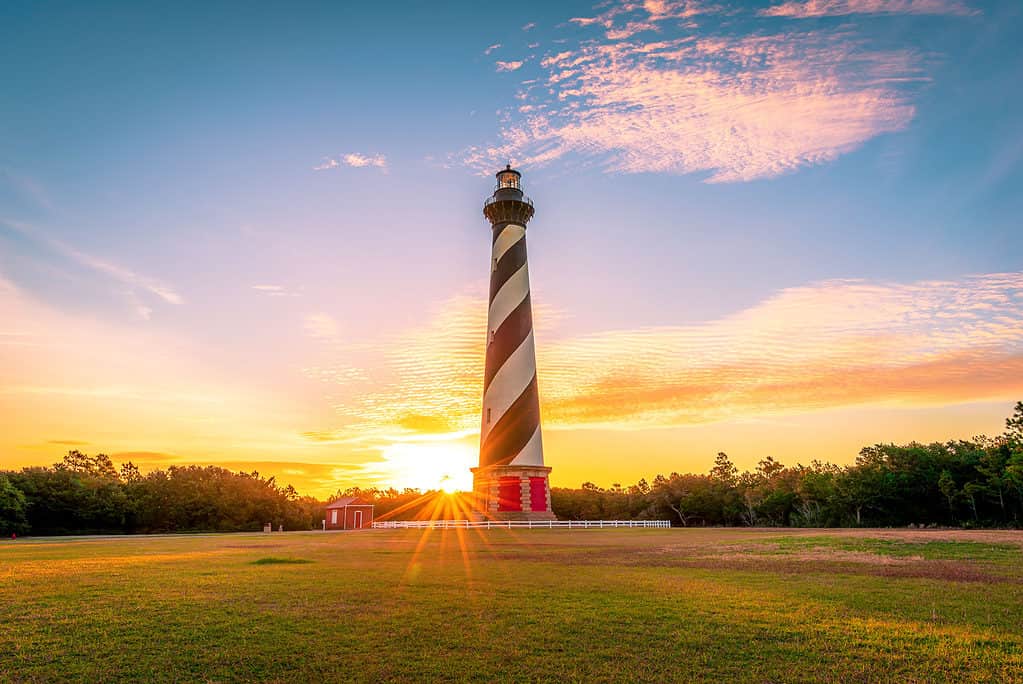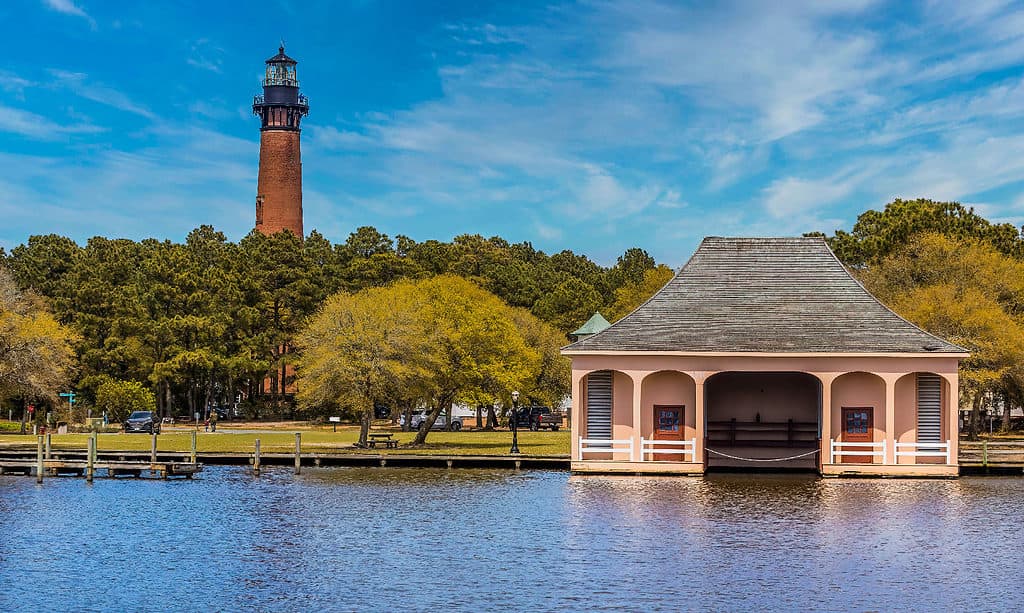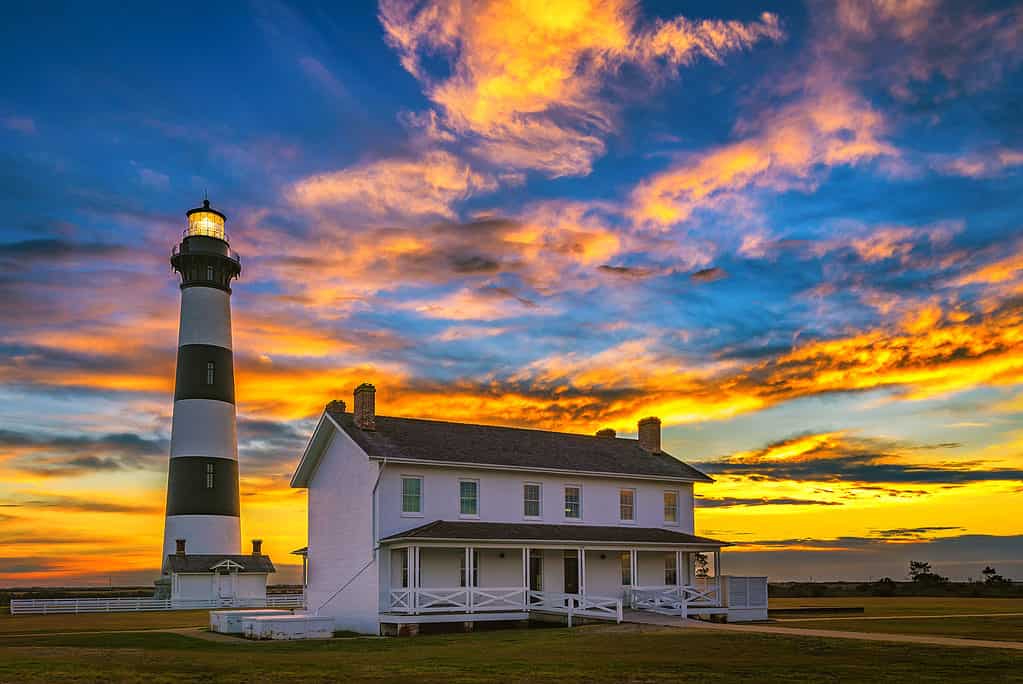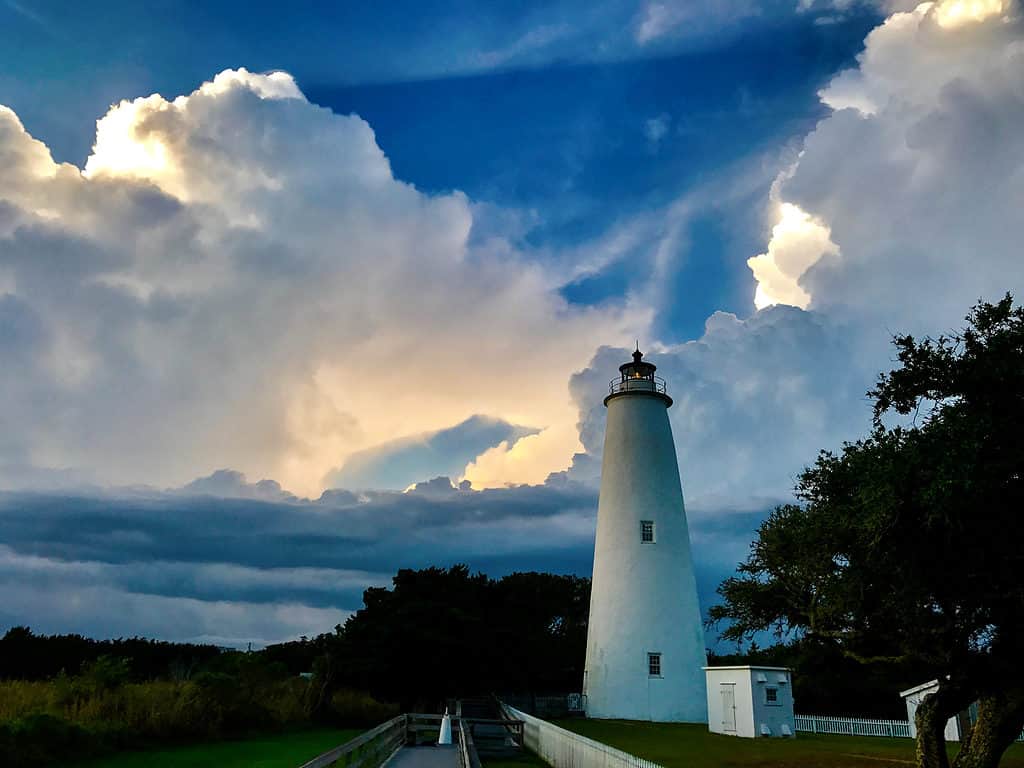The Outer Banks is a 100-mile stretch of island coastline spotted with small seaside towns and ideal opportunities for camping, sightseeing, and spending time outdoors. These islands are the site of some foundational American history as well. The first colony in America was founded in Roanoke, and the Wright Brothers staged their first flight in Kitty Hawk on December 17th, 1903. The Outer Banks is also home to a host of beautiful lighthouses. If you’re planning a visit, then read on to discover the five most beautiful lighthouses of the Outer Banks!
1. Cape Hatteras Lighthouse
The Cape Hatteras Lighthouse, standing as the world’s tallest brick lighthouse at 208 feet, boasts a unique black and white striped design that makes it one of the most well-known lighthouses.
Historical Foundations: The Three Lighthouses of Buxton
Since 1803, builders have constructed a total of three lighthouses in Buxton on Hatteras Island. Extensive structural damage from the Civil War of 1861 prompted the construction of the current lighthouse.
Reconstruction and Renewed Light: The 1870 Project
In 1870, three years after the United States Congress approved $155,000 for the project, crews rebuilt the Cape Hatteras Lighthouse. On December 16th, 1870, they lit the tower’s first-order Fresnel lens, casting a powerful beam of light over the dangerous shores of North Carolina’s Outer Banks.
A Battle Against Nature: Erosion and Proximity to the Sea
When workers first erected the tower, its base stood 1,600 feet away from the shoreline. However, years of erosion dramatically reduced this distance. By 1930, the sea had approached to within 150 feet of the Cape Hatteras Lighthouse.
Moving a Giant: The 1999 Relocation Project
By the 1990s, the urgency for a solution had grown dire. The National Park Service and the National Academy of Sciences partnered to plan the lighthouse’s move inland by 1,600 feet. In 1999, the International Chimney Corporation successfully transported the 4,800-ton lighthouse to safety. Visitors can enjoy the Cape Hatteras Lighthouse any day of the year except Christmas Day, December 25th. The lighthouse opens its doors to the public from 9 am to 5 pm year-round and from 9 am to 6 pm during the summer.

The Cape Hatteras Lighthouse is well-known for its unique black-and-white striped design.
©Chansak Joe/Shutterstock.com
2. Roanoke Marshes Lighthouse
The Roanoke Marshes Lighthouse stands at the end of a 40-yard wooden boardwalk in downtown Manteo, a tranquil and captivating town in the Outer Banks. It is the last of four lighthouses to bear the name. Technically, it qualifies as a replica, as its functioning predecessors stood at the southern tip of the Croatan Sound, where they could effectively guide mariners.
The Early Years: First and Second Lighthouses
In 1831, builders constructed the initial Roanoke Marshes Lighthouse, but it operated for only eight years before falling into disrepair. In 1857, a team built a second structure, which featured living quarters spacious enough for a lighthouse keeper and one assistant, along with a lantern room. The United States Congress funded the construction with $10,000. By April 15th of 1858, the lighthouse was fully operating with a fourth-order Fresnel lens.
The Civil War and Erosion
After briefly suspending its operations during the Civil War, the Roanoke Marshes Lighthouse resumed its duties in 1863. A decade later, erosion had claimed the land around the tower, prompting the United States Congress to approve a $15,000 budget for a third lighthouse’s construction.
The Third Lighthouse and an Unexpected End
The builders completed this iteration of the Roanoke Marshes Lighthouse by November of 1877. The lighthouse operated until the United States Coast Guard decommissioned it in 1955. The town of Manteo intended to purchase the lighthouse. However, before it could act, Elijah Tate bought and relocated the structure onto a barge for transport. Rough sea conditions during its shipment sent the lighthouse teetering into the ocean. Experts deemed it too dangerous to retrieve from the depths.
A New Beginning: The Replica Lighthouse
In 1999, Manteo initiated the construction of a Roanoke Marshes Lighthouse replica to celebrate their centennial. Multiple complications, including fundraising issues, Hurricane Isabel, and opposition from the United States Army Corps of Engineers, delayed the process until 2004. Builders completed the lighthouse on September 25th, and the Roanoke Island Maritime Museum now operates it. The lighthouse welcomes visitors Tuesday through Saturday from 9 am to 5 pm, except during the winter months.

The Roanoke Marshes Lighthouse is located in the Manteo in the Outer Banks and is a replica of the original lighthouse.
©Wileydoc/Shutterstock.com
3. Currituck Beach Lighthouse
Distinct from many of its Outer Banks counterparts, the Currituck Beach Lighthouse proudly displays its entire structure in exposed brick. This 162-foot tall tower stands near the historic mansion known as the Whalehead in Corolla, North Carolina, where it continues to aid ships at sea.
Navigating Dangerous Waters: The Call for a Lighthouse
The northern shoreline of the Outer Banks has a notorious history of being dangerous for passing vessels. After centuries punctuated by hundreds of shipwrecks, the locals’ cries for a solution culminated in the construction of a lighthouse. In 1872, construction began, and workers labored for three years to complete it.
Illuminating the Coast: The Lighthouse Comes to Life
On December 1st, 1875, the Currituck Beach Lighthouse began its duty, illuminating the last unlit section of the North Carolina coastline between the Bodie Island Lighthouse and the Cape Henry Lighthouse. The lighthouse featured a First Order Fresnel light, the largest of its kind, which projected its beams 18 miles out across the ocean to guide captains and their vessels through treacherous waters at night. The Currituck Beach Lighthouse remains one of the few towers in North America that has retained its original Fresnel lens.
A Keeper’s Home: Expansion and Modernization
In 1876, a year after the tower’s completion, the villagers of Corolla constructed a keeper’s quarters designed to house one lighthouse keeper, two assistants, and their families. By 1933, the tower and the keeper’s building had received electricity, and by the end of that decade, automation had come to the light. Despite these modernizations, the premises fell into neglect over the next forty years.
Restoration and Renewal: A Beacon Reborn
In 1980, North Carolina, with the assistance of the Outer Banks Conservationists, initiated a restoration process to breathe new life into this historic landmark.
A Welcoming Beacon Today
Now, the Currituck Beach Lighthouse stands open to visitors. The fully operating grounds include a gift shop, museum exhibits, and information centers. Committed tourists willing to climb the 220 steps to the top of the tower receive a reward—a breathtaking, one-of-a-kind view of the Currituck Sound.

The Currituck Beach Lighthouse is 162 feet tall and entirely made of exposed brick.
©Jason Schronce/Shutterstock.com
4. Bodie Island Lighthouse
The Bodie Island Lighthouse, standing at a commanding 156 feet tall, is famous for its iconic black and white stripes. In 1837, Congress and the Bodie Island locals commissioned this lighthouse, recognizing the dire need to enhance safety along this perilous stretch of coastline, nicknamed the “Graveyard of the Atlantic.”
Choosing the Ideal Location
Congress members approved a $5,000 budget to build a lighthouse initially planned for Pea Island. However, after reviewing the case and considering that more than 40 ships had wrecked near Bodie Island in the last decade alone, they decided to construct the lighthouse on Bodie Island. This location also offered easier access for transporting the necessary building materials.
Facing Initial Challenges
The lighthouse’s construction on Bodie Island faced a ten-year delay. Initially, problems arose in purchasing the land, and later, the Auditor of the Treasury consistently blocked attempts to acquire quality materials. By 1847, workers had completed the first tower on Bodie Island, although they largely ignored the initial engineer’s instructions and recommendations.
Struggling to Maintain the Beacon
Despite housing a quality fourth-order Fresnel lens, authorities condemned the lighthouse by 1854. In 1858, construction of a second lighthouse began, but Confederate Army soldiers captured it only two years later during the American Civil War, leading to its destruction in the fighting.
The Light Shines Again: Construction of the Final Lighthouse
By 1871, plans were underway for a third and final lighthouse, and a first-order Fresnel lens was ordered for the tower. Construction, which included a duplex for the lighthouse keeper, took place on 15 acres of land slightly further inland. By the following year, with the arrival of the Fresnel lens and the completion of construction, the Bodie Island Lighthouse began shining its beam 19 miles over North Carolina’s shoreline. In 1932, the tower was automated and received electric power.
Preservation and Public Access: The National Park Service’s Role
In 1953, the National Park Service took control of the Bodie Island Lighthouse and its adjacent keeper’s quarters. With their assistance, the quarters have undergone two extensive renovations and now serve as a visitor center. Last renovated in 2013, the lighthouse welcomes tourists, inviting those daring enough to climb the 214 steps to the top.

The Bodie Island Lighthouse is another black and white striped lighthouse in the Outer Banks, standing 156 feet tall.
©anthony heflin/Shutterstock.com
5. Ocracoke Island Lighthouse
The Ocracoke Island Lighthouse holds the distinction of being the oldest operating lighthouse in North Carolina and the second oldest in the country. English settlers discovered the island in 1585 when their ship sank off its shores. After nearly 200 years of development, the island became a prosperous and frequently traveled inlet on the United States east coast.
Initial Efforts to Illuminate Ocracoke Inlet
The United States Lighthouse Service, recognizing the need for a lighthouse to guide sailors through the tricky waters around the Ocracoke Inlet, originally chose Shell Castle Island—a small 25-acre island to the south—as the location. Construction took four years, but a receding shoreline and a lightning storm destroyed the tower and the keeper’s quarters in 1818 after only two decades of operation.
A New Beginning: Acquisition and Construction of Ocracoke Island Lighthouse
In 1822, understanding the area’s need for a replacement tower, the United States government acquired two acres of Ocracoke Island for $50. In 1823, Noah Porter of Massachusetts constructed the 65-foot tall tower and a one-story keeper’s quarters on the island’s southern tip.
Upgrades and Challenges: From Fresnel Lens to Civil War
In 1854, a fourth-order Fresnel lens arrived to update the lighthouse’s prior reflection system. However, the lighthouse was unofficially decommissioned during the American Civil War until Union soldiers restored the Fresnel lens in 1864.
Expanding the Keeper’s Quarters and Electrification
In 1897, builders added an extra assistant keeper’s quarters, which they later expanded in 1929. After the lighthouse received electricity in 1936, the Ocracoke Island Lighthouse’s beam could project 14 miles over the sea.
Modern Stewardship and Public Access
In 1955, the lighthouse became automated, and in 1999, the United States Coast Guard transferred control to the National Park Service. The tower still operates today, given that the waters around the Ocracoke Island inlet remain perilous to navigate. While the lighthouse itself is not open to the public, visitors can access the grounds via a 40-minute ferry ride from either Hatteras Island or North Carolina.

The Ocracoke Island Lighthouse was automated in 1955 and still operates today, as the waters around the Ocracoke Island inlet remain perilous.
©ButtermilkgirlVirginia/Shutterstock.com
The photo featured at the top of this post is © iStock.com/Mark Howard
Sources
- The Outer Banks of North Carolina, Available here: https://www.outerbanks.org/listing/cape-hatteras-lighthouse/248/
- The Outer Banks of North Carolina, Available here: https://www.outerbankslighthousesociety.org/capehatteras.html
- The Outer Banks of North Carolina, Available here: https://www.outerbanks.com/roanoke-marshes-lighthouse.html
- Lighthouse Friends, Available here: https://www.lighthousefriends.com/light.asp?ID=880
- The Town of Manteo, Available here: https://www.manteonc.gov/visitors/roanoke-marshes-lighthouse
- Currituck Outer Banks, Available here: https://www.visitcurrituck.com/places/whalehead-in-historic-corolla/
- Currituck Outer Banks, Available here: https://www.visitcurrituck.com/places/currituck-beach-light-house/
- National Park Service, Available here: https://www.nps.gov/caha/planyourvisit/bils.htm
- Lighthouse Friends, Available here: https://www.lighthousefriends.com/light.asp?ID=357
- The Outer Banks of North Carolina, Available here: https://www.outerbanks.com/bodie-island-lighthouse.html
- Lost in the Carolinas, Available here: https://lostinthecarolinas.com/outer-banks-lighthouses/
- National Park Service, Available here: https://www.nps.gov/caha/planyourvisit/ols.htm
- Village Craftsmen, Available here: https://www.villagecraftsmen.com/electrification-ocracoke-island-1936-2017-philip-howard/
- PBS North Carolina, Available here: https://www.pbsnc.org/blogs/science/ocracoke-lighthouse-makeover/
- The Outer Banks of North Carolina, Available here: https://www.outerbanks.com/ocracoke-island-lighthouse.html
Thank you for reading! Have some feedback for us? Contact the AZ Animals editorial team.






